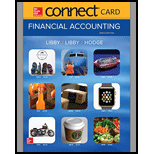
Connect Access Card for Financial Accounting
9th Edition
ISBN: 9781259738678
Author: Robert Libby, Patricia Libby, Frank Hodge Ch
Publisher: McGraw-Hill Education
expand_more
expand_more
format_list_bulleted
Concept explainers
Question
Chapter 3, Problem 3.17E
1.
To determine
Write a brief explanation for the transactions.
2.
To determine
Compute the ending balance in each account and prepare income statement and classified
Expert Solution & Answer
Want to see the full answer?
Check out a sample textbook solution
Students have asked these similar questions
I am looking for the correct answer to this general accounting question with appropriate explanations.
See an attachment for details General accounting question not need ai solution
general accounting question
Chapter 3 Solutions
Connect Access Card for Financial Accounting
Ch. 3 - Prob. 1QCh. 3 - Prob. 2QCh. 3 - Write the income statement equation and define...Ch. 3 - Explain the difference between a. Revenues and...Ch. 3 - Define accrual accounting and contrast it with...Ch. 3 - Prob. 6QCh. 3 - Explain the expense recognition principle.Ch. 3 - Explain why stockholders equity is increased by...Ch. 3 - Explain why revenues are recorded as credits and...Ch. 3 - Complete the following matrix by entering either...
Ch. 3 - Complete the following matrix by entering either...Ch. 3 - Prob. 12QCh. 3 - State the equation for the net profit margin ratio...Ch. 3 - Which of the following is not a specific account...Ch. 3 - Which of the following is not one of the criteria...Ch. 3 - The expense recognition principle controls a....Ch. 3 - Prob. 4MCQCh. 3 - Prob. 5MCQCh. 3 - Prob. 6MCQCh. 3 - Prob. 7MCQCh. 3 - Prob. 8MCQCh. 3 - Prob. 9MCQCh. 3 - Prob. 10MCQCh. 3 - Prob. 3.1MECh. 3 - Reporting Cash Basis versus Accrual Basis Income...Ch. 3 - Identifying Revenues The following transactions...Ch. 3 - Identifying Expenses The following transactions...Ch. 3 - Prob. 3.5MECh. 3 - Prob. 3.6MECh. 3 - Determining the Financial Statement Effects of...Ch. 3 - Prob. 3.8MECh. 3 - Prob. 3.9MECh. 3 - Identifying the Operating Activities in a...Ch. 3 - Prob. 3.11MECh. 3 - Prob. 3.1ECh. 3 - Reporting Cash Basis versus Accrual Basis Income...Ch. 3 - Identifying Revenues Revenues are normally...Ch. 3 - Identifying Expenses Revenues are normally...Ch. 3 - Prob. 3.5ECh. 3 - Determining Financial Statement Effects of Various...Ch. 3 - Recording Journal Entries Sysco, formed in 1969,...Ch. 3 - Prob. 3.8ECh. 3 - Prob. 3.9ECh. 3 - Analyzing the Effects of Transactions in...Ch. 3 - Preparing an Income Statement Refer to E3-10....Ch. 3 - Prob. 3.12ECh. 3 - Analyzing the Effects of Transactions in...Ch. 3 - Prob. 3.14ECh. 3 - Prob. 3.15ECh. 3 - Prob. 3.16ECh. 3 - Prob. 3.17ECh. 3 - Prob. 3.18ECh. 3 - Prob. 3.19ECh. 3 - Prob. 3.20ECh. 3 - Prob. 3.1PCh. 3 - Recording Journal Entries (AP3-2) Ryan Terlecki...Ch. 3 - Prob. 3.3PCh. 3 - Prob. 3.4PCh. 3 - Prob. 3.5PCh. 3 - Prob. 3.6PCh. 3 - Prob. 3.7PCh. 3 - Recording Nonquantitative Journal Entries (P3-1)...Ch. 3 - Prob. 3.2APCh. 3 - Prob. 3.3APCh. 3 - Prob. 3.4APCh. 3 - Prob. 3.5APCh. 3 - Prob. 3.6APCh. 3 - Accounting for Operating Activities in a New...Ch. 3 - Finding Financial Information Refer to the...Ch. 3 - Finding Financial Information Refer to the...Ch. 3 - Comparing Companies within an Industry Refer to...Ch. 3 - Analyzing a Company over Time Refer to the annual...Ch. 3 - Prob. 3.6CPCh. 3 - Evaluating an Ethical Dilemma Mike Lynch is the...
Knowledge Booster
Learn more about
Need a deep-dive on the concept behind this application? Look no further. Learn more about this topic, accounting and related others by exploring similar questions and additional content below.Similar questions
- Organic Harvest Inc. sells 40-pound bags of apples to grocery stores for $12 per bag. The fixed costs of the operation are $84,000, and the variable cost of apples is $0.15 per pound. What is the break-even point in bags? a) 5,600 bags b) 7,000 bags c) 8,400 bags d) 10,200 bagsarrow_forwardPlease given correct answer for General accounting question I need step by step explanationarrow_forwardWhat is the correct option? The general accounting question do fast explanationarrow_forward
- Can you help me solve this general accounting problem using the correct accounting process?.arrow_forwardI want to this question answer for General accounting question not need ai solutionarrow_forwardCan you provide the accurate answer to this financial accounting question using correct methods?arrow_forward
arrow_back_ios
SEE MORE QUESTIONS
arrow_forward_ios
Recommended textbooks for you
 College Accounting, Chapters 1-27 (New in Account...AccountingISBN:9781305666160Author:James A. Heintz, Robert W. ParryPublisher:Cengage Learning
College Accounting, Chapters 1-27 (New in Account...AccountingISBN:9781305666160Author:James A. Heintz, Robert W. ParryPublisher:Cengage Learning Accounting Information SystemsAccountingISBN:9781337619202Author:Hall, James A.Publisher:Cengage Learning,
Accounting Information SystemsAccountingISBN:9781337619202Author:Hall, James A.Publisher:Cengage Learning, College Accounting, Chapters 1-27AccountingISBN:9781337794756Author:HEINTZ, James A.Publisher:Cengage Learning,
College Accounting, Chapters 1-27AccountingISBN:9781337794756Author:HEINTZ, James A.Publisher:Cengage Learning,- Principles of Accounting Volume 1AccountingISBN:9781947172685Author:OpenStaxPublisher:OpenStax College
 Financial AccountingAccountingISBN:9781337272124Author:Carl Warren, James M. Reeve, Jonathan DuchacPublisher:Cengage Learning
Financial AccountingAccountingISBN:9781337272124Author:Carl Warren, James M. Reeve, Jonathan DuchacPublisher:Cengage Learning Cornerstones of Financial AccountingAccountingISBN:9781337690881Author:Jay Rich, Jeff JonesPublisher:Cengage Learning
Cornerstones of Financial AccountingAccountingISBN:9781337690881Author:Jay Rich, Jeff JonesPublisher:Cengage Learning

College Accounting, Chapters 1-27 (New in Account...
Accounting
ISBN:9781305666160
Author:James A. Heintz, Robert W. Parry
Publisher:Cengage Learning

Accounting Information Systems
Accounting
ISBN:9781337619202
Author:Hall, James A.
Publisher:Cengage Learning,

College Accounting, Chapters 1-27
Accounting
ISBN:9781337794756
Author:HEINTZ, James A.
Publisher:Cengage Learning,

Principles of Accounting Volume 1
Accounting
ISBN:9781947172685
Author:OpenStax
Publisher:OpenStax College

Financial Accounting
Accounting
ISBN:9781337272124
Author:Carl Warren, James M. Reeve, Jonathan Duchac
Publisher:Cengage Learning

Cornerstones of Financial Accounting
Accounting
ISBN:9781337690881
Author:Jay Rich, Jeff Jones
Publisher:Cengage Learning
The ACCOUNTING EQUATION For BEGINNERS; Author: Accounting Stuff;https://www.youtube.com/watch?v=56xscQ4viWE;License: Standard Youtube License